
The importance of de-energizing EV and Hybrid Vehicles

Examples of Following Safety Guidelines
for Ford, VW and Kia
Industry experts speculate that auto manufacturers will soon be adopting 800-volt electrical systems in their electric vehicles (EVs). The latest research shows that 800-volt electrical systems can lead to smaller, lighter, and more environmentally friendly motors. Vehicles using these powertrains could also be charged faster and travel further on a single charge. Porsche is one of the companies who has already embraced this technology. They have installed an 800-volt system in their fully electric Taycan, which was launched last year.
Getting seriously injured when working with high-voltage automotive electrical systems is a legitimate concern. Current EV and Hybrid vehicles have electrical systems that average 450-650 volts. One can only imagine the dangers of working with almost twice that amount of voltage.
Some of you may be wondering if working on EV and Hybrid vehicles is worth the risk. Rest assured, if you follow OEM safety information, get the right training and wear high quality protective equipment, you can considerably reduce or even eliminate those risks.
In this article, we will cover a few manufacturer-specific safety tips and guidelines aimed at keeping you safe. I’ll also give you the specific pathway to finding this information in ALLDATA.
De-energizing a High-voltage System Without a Scan Tool, Ford Hybrid
Pathway to Information in ALLDATA: Vehicle > Hybrid Drive Systems > High Voltage System Disable / Enable, Hybrid > Service and Repair Procedures > High Voltage System De-Energizing)
Here is a great example of how to safely de-energize and re-energize a high-voltage system manually without using the factory scan tool on a 2020 Ford Explorer, 2WD, V6-3.3L Hybrid.
Procedure
WARNING: To prevent the risk of high-voltage shock, always precisely follow all warnings and service instructions, including instructions to de-energize the system. The high-voltage system utilizes approximately 450 volts DC, provided through high-voltage cables to its components and modules. The high-voltage cables and wiring are identified by orange harness tape or orange wire covering. All high-voltage components are marked with high-voltage warning labels with a high-voltage symbol. Failure to follow these instructions may result in serious personal injury or death.
NOTICE: Manual De-energization should only be performed when a Ford – specific diagnostic tool is not available.
NOTICE: Excessive use of this method may cause damage to electrical connectors.
NOTICE: To prevent the risk of high voltage shock, the high voltage battery cover must not be removed if any of the following conditions exist:
- BECM DTC P0AA6:00 that has been diagnosed to be an internal fault with the high voltage Battery.
- BECM Diagnostic Trouble Codes (DTCs) P0AA1:00 AND P0AA4:00 are present.
- BECM Diagnostic Trouble Codes (DTCs) P0D0F:00 AND P0AA4:00 are present (PHEV only).
WARNING: Before beginning any service procedure, refer to High Voltage System Health and Safety Precautions – Overview in ALLDATA. Failure to follow this warning may result in serious personal injury.
- Disconnect the Electric Vehicle Supply Equipment (EVSE) from the vehicle charge port. (PHEV only).
- Turn the ignition ON without depressing the brake pedal (Accessory mode).
- NOTE: A scan tool that can perform a self-test on the BECM is required.
- Using a scan tool perform BECM self-test and record the Diagnostic Trouble Codes (DTCs).
- If BECM Diagnostic Trouble Codes (DTCs) P0AA1:00 AND P0AA4:00 are present. Refer to: High Voltage Battery, Mounting and Cables (414-03 High Voltage Battery, Mounting and Cables, Diagnosis and Testing).
- If BECM Diagnostic Trouble Codes (DTCs) P0D0F:00 AND P0AA4:00 are present (PHEV only). Refer to: High Voltage Battery, Mounting and Cables - Plug-In Hybrid Electric Vehicle (PHEV) (414-03A).
- Turn the ignition OFF.
- Detach the pin-type retainer and position the electrical connector and wiring harness aside.
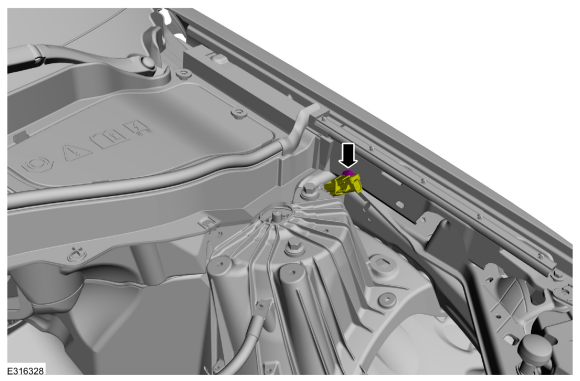
- Release the Connector Position Assurance (CPA) clip.
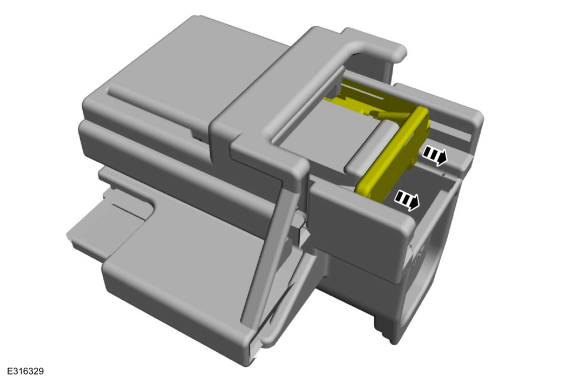
- Depress the tab while pulling the connector until the hole is completely visible on the top of the connector.
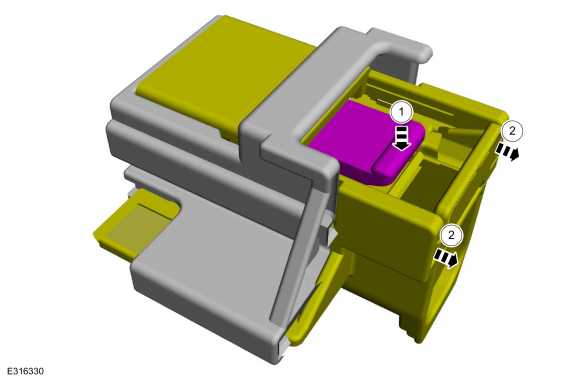
- Insert a suitable tool inside the connector hole to prevent the connector from closing.
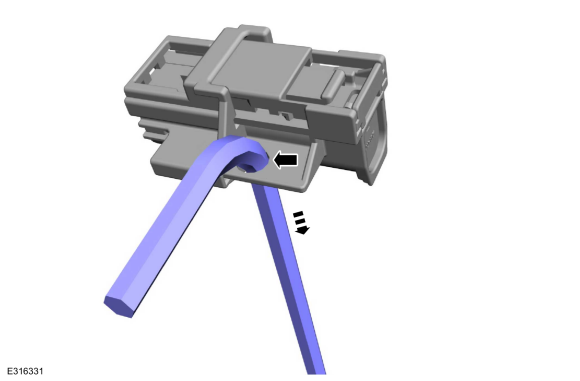
- Disconnect the LOW voltage electrical connector at the high voltage battery.
- Disconnect the HIGH voltage electrical connector at the high voltage battery.
- Wait a minimum of 5 minutes.
Re-energizing the High-Voltage System
WARNING: To prevent the risk of high-voltage shock, always precisely follow all warnings and service instructions, including instructions to depower the system. The high-voltage system utilizes approximately 450 volts DC, provided through high-voltage cables to its components and modules. The high-voltage cables and wiring are identified by orange harness tape or orange wire covering. All high-voltage components are marked with high-voltage warning labels with a high-voltage symbol. Failure to follow these instructions may result in serious personal injury or death.
- Remove the suitable tool from the connector hole. NOTE: The tab must be depressed prior to pushing the connector back in or damage to the connector may result.

- Depress the tab while pushing the connector until the hole is not visible on the top of the connector.

- Push the Connector Position Assurance (CPA) clip until it touches the connector body.

- Attach the pin-type retainer.

VW Safety Tips for Collision Repair Shops
Nobody knows the dangers of EV and hybrid vehicle repair better than collision repair shops. Wrecked vehicles are towed in with leaking batteries, smashed wiring harnesses and damaged high-voltage components, which can all be very dangerous. Here are some collision-focused safety tips from Volkswagen on their 2019 e Golf (BE2), ELE-Electric Engine (EAZA).
Pathway to Information in ALLDATA: Vehicle > Electric Drive Systems > High Voltage System Disable / Enable, Electric Drive > Service and Repair > Procedures > Body Work Requiring System to be De-Energized)
Procedure
High-Voltage System De-Energizing for Body Work
- The high-voltage system must only be de-energized using guided fault finding.
- When performing welding, sanding or cutting procedures near the high-voltage components, the system must be de-energized by a high-voltage trained technician.
- The system must be de-energized by a high-voltage-trained technician if using the straightening rack for body procedures.
- Procedures after de-energizing may only be done by technicians trained in electrical systems.
DANGER: Life threatening danger by electrocution or electric arcs when high-voltage components and high-voltage cables are damaged.
- Perform a visual inspection of the high-voltage components and the high-voltage cables.
- Never use cutting, shaping, or sharp-edged tools near high-voltage components and high-voltage cables.
- Never weld, solder, or use thermal bonding or hot air near high-voltage components and high-voltage cables.
- Work on high-voltage components and electric vehicles may only be done by properly trained and qualified personnel.
Kia Niro Electric Vehicle High-Voltage Cut-Off Procedures
The 2019 Kia Niro, ELE-Electric Engine has a 64-kW-hr lithium-ion battery and electric motor that makes 201 hp and 291 lb.-ft of torque. In many reviews, the Niro EV was praised for its good handling and readily available power. When you need to work on this electric vehicle, Kia has some valuable safety procedures to chop the power to its 356-volt system.
Pathway to Information in ALLDATA: Vehicle > Electric Drive Systems > High Voltage System Disable / Enable, Electric Drive > Service and Repair > Procedures > High Voltage Shut-off Procedures
High-voltage Cut-off Procedure
WARNING: When working on the high voltage system, make sure that you are familiar and comply with the "Safety Precautions, Cautions and Warnings." If you do not comply with the instructions, serious accidents due to electric shock or leakage may occur.
WARNING: When working on the high voltage system, make sure to cut off the high voltage first according to the "High Voltage Cut-off Procedure." If you do not comply with the instructions, serious accidents due to electric shock or leakage may occur.
High-voltage System Component List:
- High Voltage Battery
- Power Relay Assembly (PRA)
- High Voltage Junction Box Assembly
- Motor
- Power Cable
- BMS ECU
- Inverter
- LDC
- On-Board Charger (OBC)
- Main Relay
- Pre-Charge relay
- Re-Charge Resistor
- Battery Current Sensor
- Service Plug
- Main Fuse
- Battery Temperature Sensor
- Busbar
- Charging Port
- Electric Compressor
- Electronic Power Control Unit (EPCU)
- High Voltage Heater
- High Voltage Heater Relay
Procedure
- Turn OFF the ignition and disconnect the negative (-) cable on the auxiliary battery (12V).
- Remove the rear seat cushion assembly.
- Remove the service plug cover (A).
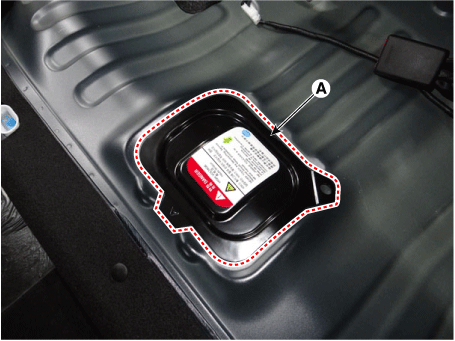
- Remove the service plug (A).
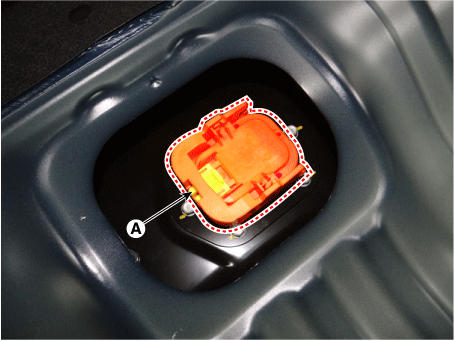
- Remove the service plug in the following order.

- Be sure to wait 5+ minutes for the capacitor inside the inverter to discharge after removing the service plug.
- Measure the voltage between the inverter terminals to check that the inverter capacitor is discharged.
- Lift the vehicle.
- Remove the front under cover (A).
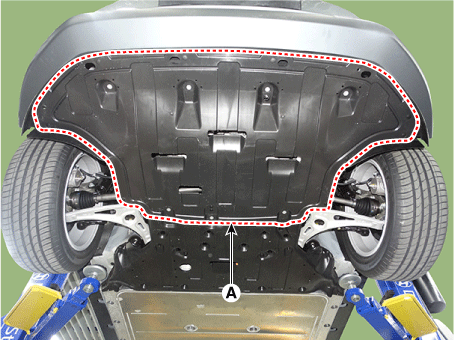
- Remove the rear under cover (A).
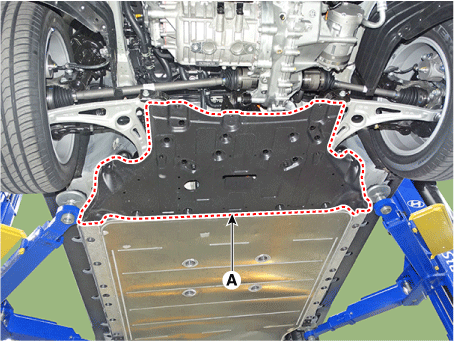
- Disconnect the high voltage cable (A).
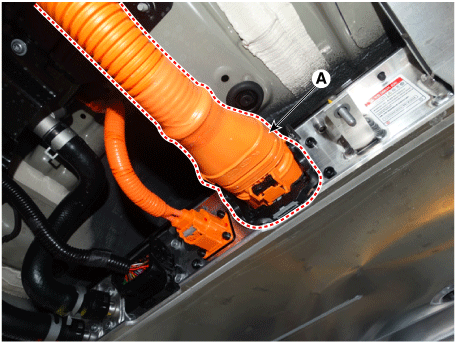
- Remove the high voltage cable in the following order.

- Measure the voltage between the high voltage terminals to check that the inverter capacitor is discharged.
- 30V or below: High voltage circuit normal cut-off
- Over 30V: High voltage circuit failure
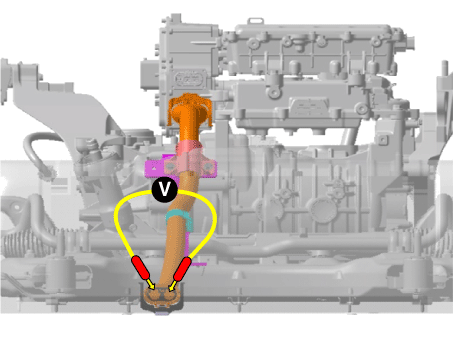
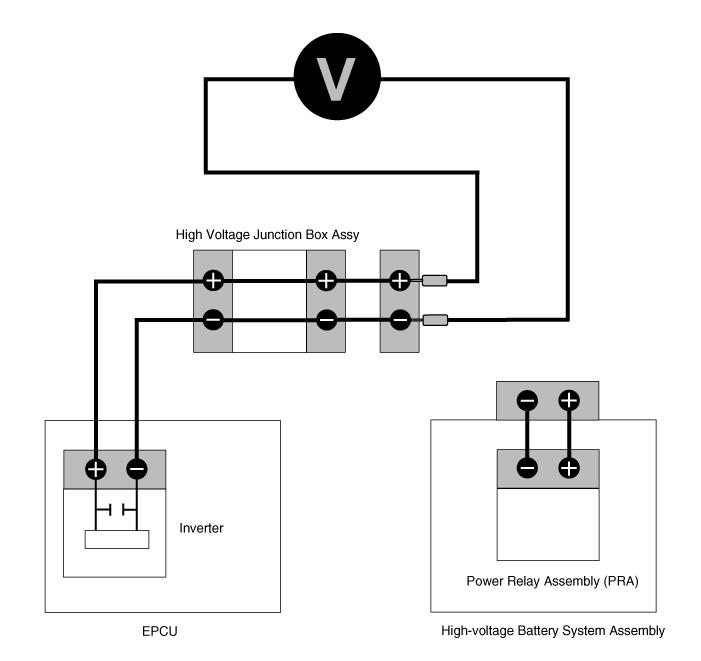
WARNING: If a voltage reading of 30V or greater is taken, check the service plug removal status. If a voltage reading of 30V or greater is taken although the service plug is removed, there could be a serious problem in the high voltage circuit. If this occurs, perform a DTC troubleshooting inspection first. Do not touch any component related to the high voltage system (see high-voltage system component list above).
Look at our entire suite of products to determine your shop’s needs.
If you would like to read more articles like this one please subscribe to ALLDATA News.
About the author
Rich Diegle, Supervisor of the ALLDATA Tech-Assist Team, has 35 years of experience as a master automotive technician, marketing and public relations manager, senior automotive editor, and instructor.






